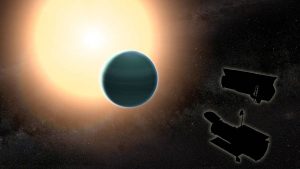Astronomers have detected water in the skies of "warm Neptune" HAT-P-26b — a clue to the larger mystery of how these planets formed.

NASA / GSFC
Among the first planets discovered outside our solar system were those that appeared impossible. Hot Jupiters, and their smaller cousins, hot Neptunes, orbit their host stars searingly close. That puts astronomers in a bit of a quandary when it comes to explaining their formation: Gas and ice giants are thought to form far from their star, so how did these planets come to be?
Now, detailed observations of a warm Neptune, HAT-P-26b, offer a clue to how these planets come together.
Making Hot Jupiters and Warm Neptunes
Astronomers long thought that giant planets could only form beyond a system's frost lines, the lines beyond which molecules such as methane, water, and carbon dioxide freeze. With gases frozen into icy shards, there was far more material available for building planets. Closer to the star, those ices would sublimate into gas, making them unavailable for accretion.
Two scenarios get around that problem. The first is migration: gas giants could form far out beyond the frost line, then interact with the disk, a passing star, or another planet to move inward. The second is in situ formation: the idea that somehow, enough material was available close to the star to form hot giants where they now orbit.
Hats Off to HAT-P-26b
HAT-P-26b, a Neptune-mass planet 425 light-years away, passes in front of its star every 4 Earth days. So, every 4 days, it presents a good target for transmission spectroscopy: the method of capturing the sliver of starlight that passes through the planet's atmosphere. Hannah Wakeford (NASA Goddard) and colleagues used the Hubble Space Telescope to take that spectrum during four of the planet's transits. They also used archival Spitzer observations taken during two additional transits. Altogether, they reconstructed a spectrum spanning wavelengths between 0.5 and 5 microns — an ideal range when it comes to looking for water.
And they found what they were looking for: the spectrum shows some light cloud cover and a clear signature of water in the planet's gaseous envelope. Water serves as a representative of all the elements in the atmosphere heavier than hydrogen and helium. From the presence of water, it turns out that HAT-P-26b has 4.8 times as many heavy elements as the Sun, a measurement surprisingly close to Jupiter's (5 times greater than the Sun), and not so close to the measurement for Neptune (about 100 times greater than the Sun). So maybe we'd be better off calling the planet a warm-but-small Jupiter.
It's worth noting, that collecting a transmission spectrum isn't a precise science yet, and there's still a large range of uncertainty in this measurement: the true abundance of heavy elements in the planet's atmosphere could range from 0.8 to 26 times the Sun's value. Still, even with that large uncertainty, the planet bucks the trend we see in our own solar system: massive planets typically have fewer heavy elements, while less massive planets have more. Given that it's Neptune-mass, HAT-P-26b ought to have a lot more heavy elements than it does.
So, just like the much more massive Jupiter, HAT-P-26b appears to be made of mostly hydrogen and helium. And since that primordial mixture has apparently remained relatively undisturbed by heavier elements that might come in during the early phases of planet formation, this planet must have come together relatively late during the system's formation. A late formation wouldn't give it much time to migrate inward, Wakeford and colleagues argue, so the planet probably formed in situ instead, gathering its bulk from the inner reaches of this stellar system.
 0
0
Comments
You must be logged in to post a comment.